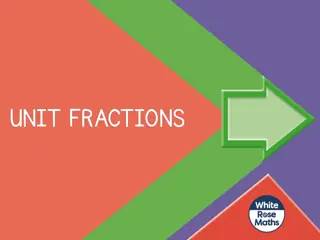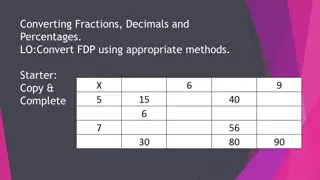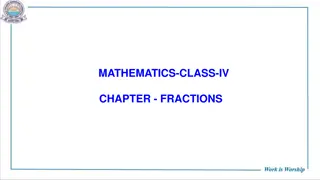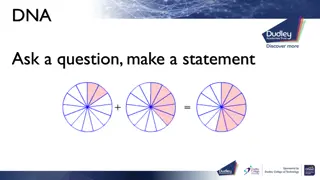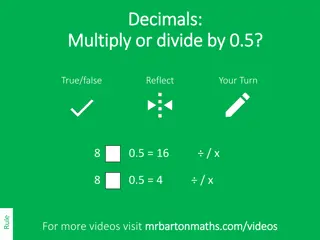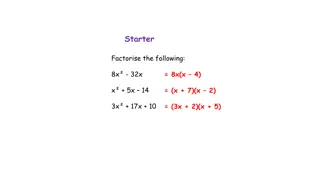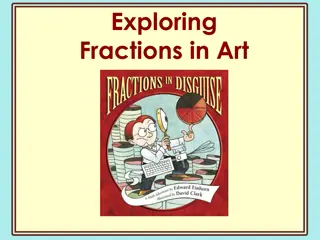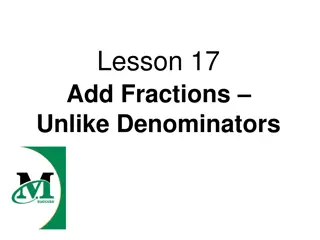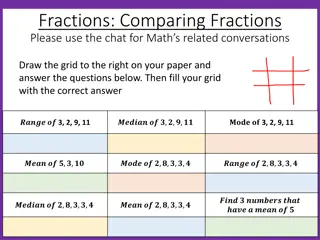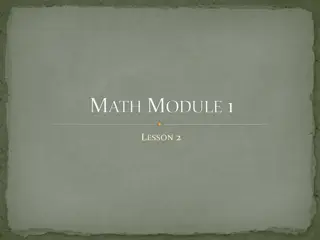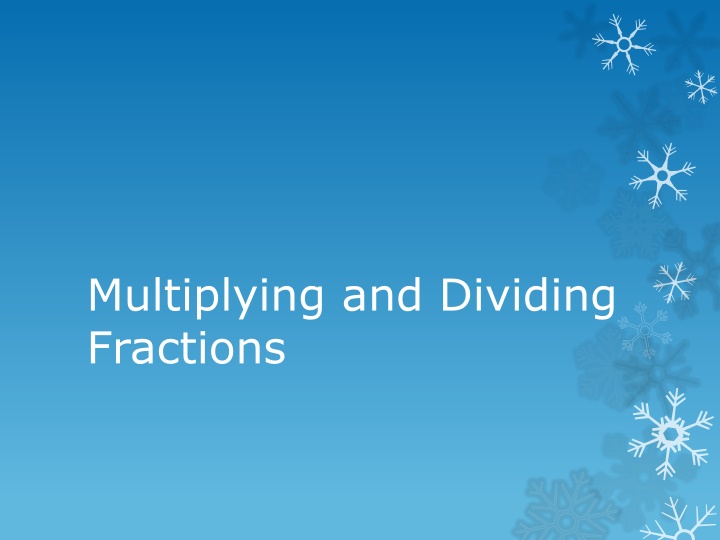
Fraction Multiplication and Division
Learn the fundamentals of fraction multiplication and division, including identifying parts of a fraction, types of fractions, multiplying fractions and whole numbers, multiplying mixed numbers, canceling down before and after multiplication. Improve your fraction skills with helpful tips and examples.
Download Presentation

Please find below an Image/Link to download the presentation.
The content on the website is provided AS IS for your information and personal use only. It may not be sold, licensed, or shared on other websites without obtaining consent from the author. If you encounter any issues during the download, it is possible that the publisher has removed the file from their server.
You are allowed to download the files provided on this website for personal or commercial use, subject to the condition that they are used lawfully. All files are the property of their respective owners.
The content on the website is provided AS IS for your information and personal use only. It may not be sold, licensed, or shared on other websites without obtaining consent from the author.
E N D
Presentation Transcript
Multiplying and Dividing Fractions
Can you name the parts of a fraction? ? 3 4 numerator ? denominator
What sort of fractions / numbers are these: 7 8 ? proper fraction ? 23 mixed number 8 ? 9 7 improper fraction
Multiplying Fractions 1 2 2 3 3 2 3 6 3 4 12= = 4= 1. Multiply the numerators. 2. Multiply the denominators. 3. Cancel down.
6 20=3 2 30=1 2 5 3 1 6 2 4= 5= 10 15 1 8 10 60=1 1 4 1 5 12 2 2= 5= 6 10 27 3 4 4 12 20=3 5 9 2 5= 3= 5 4 7 2 8 12 72=1 3 8 4 5= 9= 6 35
Multiplying mixed numbers. 12 5 1 22 5 1 10= 6 5= 11 2= 12 = 2 5 1. Change the mixed number to an improper fraction. 2. Multiply as before. 3. Cancel down and change to mixed number if necessary.
11 4 2 5 4 2 7 = 10 5 14 7= 28= 7 3 1 7 6 = 11 21 3 1 2 = 2= 6 3 4 9 27 20 = 17 3 4 14 5 = 5= 20 11 7 7 77 35 = 11 5 =21 14 7 12 5 = 5= 5
Multiplying fractions and whole numbers 6 = 60 12 5 12 1 5 6= 6= 10 1. Whole numbers have a denominator of 1. 2. Multiply numerators and denominators. 3. Cancel down and change to a mixed number if necessary.
3 4 6 1=18 4= 41 3 4 6 = 2 7 8 12 = 7 8 12 1=84 8= 101 2 5 1 3 10=15 10= 11 3 10 = 5 2 5 7 4 = 5 7 4 1=20 7= 26 7 7 1 2 5=14 5= 24 7 2 5= 5
Cancelling down. It is often easier to cancel down before you multiply. When you are multiplying fractions, any numerator can be cancelled against any denominator. After multiplication 5 8 16 25 = 80 200 = 2 5 Before multiplication 2 1 2 5 5 8 16 1 25 = 5
Cancelling after multiplication 7 12 16 49 = 112 588 = 4 21 Cancelling before multiplication 4 1 4 21 7 12 16 49 = 7 3 Which is easier?
Multiplying always makes things bigger: 2 x 3 = 6 6 is bigger than both 2 and 3 Is he correct?
If you multiply a number by 1, it does not increase or decrease. 3 x 1 = 3 If you multiply a number by 0, you get 0 3 x 0 = 0 If you multiply a number larger than 1 by a proper fraction, the product is less than the original number. 4 x 1 2 = 2 (2 < 4)
If you multiply two proper fractions together, the product is less than either of them: 3 4 1 2 = 3 8 of means 1 2of 3 4 = 3 3 4of 1 2 = 3 8 8 = =
Dividing Fractions 3 4 1 3 3 1 3 3 4 =21 1 = 9 = 4 4 1. Turn the dividing fraction upside down and change to . 2. Multiply numerators and denominators. 3. If necessary cancel down and change to a mixed number.
5=13 = 15 14 = 8 4 1 4 2 5 2 5 1 4 = 1 5 3 7 3 7 2 5 2 1 14 5 = =1 5 2 8 = 24 3 4 1 8 3 4 1 8 1 =6 = 4 =21 = 15 3 1 3 1 5 6 5 6 1 3 = 2 6 4 9 1 2 1 2 = 8 4 9 1 2 = 9
Dividing mixed numbers. 12 5 1 22 5 1 5=44 12 5 2 1 =24 = 2= 5 2 1. Change the mixed number to an improper fraction. 2. Divide as before. 3. Cancel down and change to a mixed number if necessary.
14 1 3= 9 5 1 3 = 9 5 3 1 = 27 5 = 52 5 5 21 7 9= 7 3 7 9 =7 3 9 7 = 63 3 21 = 3 31 3 8= 7 2 3 8 =7 2 8 3 = 56 6 = 91 2 3 11 3 7 6 =11 3 6 7 = 66 21 = 31 32 3 11 6= 7 10 11 9 10 6 9 10 5 9 6 = 45 60 = 3 5= 5 = 4
Dividing fractions and whole numbers = 131 = 40 5 3 5 3 8 1 8 3 5= 3 3 1. Whole numbers have a denominator of 1. 2. Turn dividing fraction upside down and multiply numerators and denominators. 3. Cancel down and change to a mixed number if necessary.
6 1 2 6 1 3 2= 18 2= 9 2 3 = 3= 6 4 1 2 4 1 5 2= 20 2= 10 2 5 = 5= 4 7 1 5 7 1 6 5= 42 5= 82 5 6 = 6= 7 5 5 1 6 5 1 7 6= 35 6= 55 6 7 = 7= 5 6 8 1 7 8 1 9 7= 72 7= 102 7 9 = 9= 8 7 3 4 6 3 4 1 6= 3 24=1 3 4 6 = 1= 8
Division always makes things smaller. If I divide up a rich, tasty chocolate cake, I always get a smaller piece than the whole cake. 12 4=3 3 is less than 12 Is she correct?
If you divide a number by 1, it does not increase or decrease. 3 1 = 3 If you divide 1, or a number larger than 1, by a proper fraction, the answer is greater than the original number. 1 2= 8 (8 > 4) 4
If you divide a larger fraction by a smaller one, the answer will be more than 1. 3 4 1 8 = 6 = 6 How many 1 8 are there in 3 4? 6



